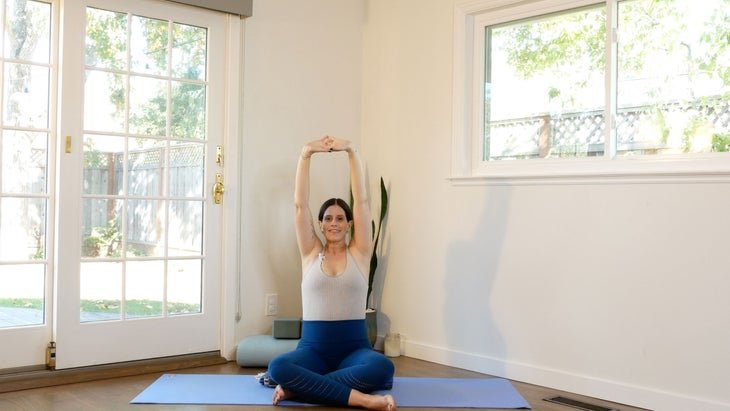“], “filter”: { “nextExceptions”: “img, blockquote, div”, “nextContainsExceptions”: “img, blockquote, a.btn, a.o-button”} }”>
I’m just going to say it: I find a lot of prenatal yoga classes to be slow and, frankly, boring.
Hear me out. I’ve been teaching yoga for more than 15 years and am pregnant with my second child. I love the camaraderie that I experience when I attend prenatal yoga in person, which I emphatically believe to be beneficial during pregnancy. I also learn an incredible amount every time I take a prenatal class.
However, during both of my pregnancies, I have chosen to continue practicing strong vinyasa flows while modifying the poses to accommodate my changing body. It’s not unlike what I do at other times, given that I always adjust my practice according to my circumstances that day—whether it’s due to lack of sleep, feeling anxious or low, or tending an injury. Right now, I just happen to be accommodating a growing baby.
See also: More Prenatal Yoga
Why do many prenatal classes tend to be so slow?
Marla Lucas PA-C, a primary care provider in San Francisco, did yoga for the first time during pregnancy. Lucas has always been active. She grew up playing sports, still loves to work out, and purposefully sought out prenatal yoga because she wanted to find a less-intense form of movement. While she enjoyed the community aspect of class and the emphasis on connecting parent to baby, the prenatal classes she took felt too slow and static for her.
Many prenatal classes might be less intense or move more slowly because they are “designed to be accessible,” explains Desi Bartlett, M.S., CPT E-RYT, and the founder of the popular Mothers into Living Fit program. She suggests that many people who attend prenatal yoga classes tend to be brand new to the practice.
Bartlett, who has been teaching prenatal yoga since 2007, understands why yoga teachers and others might have an innate desire to protect expecting people in their classes, but she also reassures us that pregnant people are far from delicate flowers. She points out that nature does a lot of the protection for us. “Babies are shielded with amniotic fluid, the walls of the uterus, layers of muscle and even the flesh of the parent’s body,” explains Bartlett.
She feels that a skillful multi-level prenatal class—one that challenges regular practitioners yet is adaptive for newer students—is possible. That is exactly how she seeks to teach her classes, trainings, and workshops, and it is also the theme of her recent book, Your Strong Sexy Pregnancy.
Bartlett suspects that one possible contributor to why many prenatal workout classes—whether yoga, cardio, or otherwise—tend to be less intense is that the American College of Obstetricians and Gynecologists (ACOG) guidelines and accompanying studies don’t often measure pregnant people in intense workouts. She theorizes this may be due to liability issues. As a result of the lack of data, many classes and instructors prefer to keep things safe.
See also: Nurture the First Trimester of Pregnancy With Yoga & Ayurveda
Pregnant women are warriors
There are a number of incredible athletes reminding us every day that pregnant women are warriors. Most recently, heptathlete Lindsay Flach competed in the Tokyo 2021 Olympic trials at 18 weeks pregnant. In 2017, Serena Williams won the Australian Open while in her first trimester, a time when many expecting parents are curled up in bed with crackers! In 2007, Gabby (Gabrielle) Reece competed in beach volleyball tournaments at five months pregnant.
These powerful women remind us that pregnant people do not need to be bubble wrapped. They need to be empowered.
Northern California-based OB-GYN Dr. Jacqueline Dela Merced concurs. “At our practice, we highly encourage and even recommend pregnant people continue their exercise regime throughout pregnancy. Most may not be up for exercising during the first trimester due to extreme fatigue and nausea, but in the second trimester, exercise can be resumed and/or initiated.” She suggests that as long as there is no pain and you have made appropriate adjustments for your body’s changes, then it is OK if your “main goal is to break a sweat.”
Some of Dela Merced’s patients were ultra-marathoners and dedicated CrossFitters who worked out until the day they gave birth. As long as you’re experiencing an uncomplicated pregnancy and your health care provider approves, then you can continue with some measure of whatever physical activity you did before pregnancy, as long as it feels good.
Here are a few considerations if you choose to continue doing strong yoga practices during pregnancy:
Listen to your body
This changes trimester-to-trimester, but overall, it means taking breaks when you need to and avoiding poses that feel uncomfortable or painful. Bartlett asks that rather than judge what we think someone “should or shouldn’t do,” instead “recognize the wisdom of each person’s expecting body.”
If you have never done a challenging pose before, pregnancy might not be the time to start.
This is due to myriad reasons, from changes to your balance to relaxin, which is a hormone the body secretes upon conception that loosens the connective tissue throughout the body and leads to increased mobility. For example, learning handstands in pregnancy might not be the best time, but if you already have a regular inversion practice, you might continue inverting up into the third trimester. Check with your body, your provider, and consider a wall for balance!
“It depends.”
No two words hold greater power in your yoga practice, pregnancy, or parenting. There is never one way, and the real yoga practice is not how sweaty you get, but how well you take care of yourself in that moment. Everything changes constantly and you need to be flexible in more than just your body.
See also: 3 Grounding Practices for the Second Trimester of Pregnancy
A strong warrior prenatal sequence
This practice is for days when you feel strong. Please note, this sequence might be best suited for your second trimester (weeks 14–28). Listen to your body and always get approval from your provider before starting any kind of physical activity.
Sukhasana (Easy Pose) with Urdhva Baddhanguliyasana (Upward Hands Pose)
Why it works during pregnancy: This pose is appropriate for almost any prenatal practice due to its accessibility. It is a place where you can ground and connect with your body, breath, and baby. The leg position is a subtle release for your hips, while the arm position opens your upper back and shoulders, which tend to tighten as your body grows forward.
How to: Sit on the floor or a folded blanket with your right shin crossed in front of your left. If you can, stack your ankles and knees. (If your ankles are sensitive, you may place a towel or rolled blanket on either side for padding.) Reach your arms straight out in front of your chest and interlace your fingers. Slowly inhale your arms up. Press through the thumb side of your hand and pull your pinkie fingers toward your head. Stay here for 5 breaths. On an exhalation, lower your arms. Switch the crossing of your legs and when you interlace again, go one finger over to change your shoulder opener.
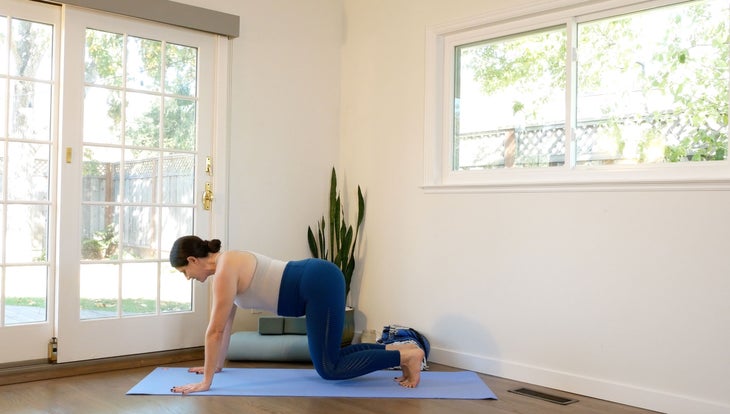
Tabletop With Toes Curled and Knees Hovering
Why it works during pregnancy: A common suggestion you hear from prenatal teachers and providers is to “make room for baby.” What this means is that poses such as deep twists or core work might not be the wisest choice in pregnancy. But just because you can’t crunch or fully twist in Marichyasana III doesn’t mean you can’t work on strengthening your core muscles. This variation on Tabletop targets your deepest abdominal layer, the transverse abdominus, which acts like a corset to support baby and your spine.
How to: Come into Tabletop position with your wrists underneath your shoulders and your knees below your hips. Tuck your toes under. On an exhalation, lift your knees and shins off the floor an inch or less and hover. Work to keep your back neutral (neither arching nor rounding) by imagining yourself lifting your baby toward your spine with your belly. Look straight down between your thumbs. Stay here for 5 breaths. Lower your shins back to the floor and rest. Repeat. After your final round, lift your hips up and back into Adho Mukha Svanasana (Downward-Facing Dog Pose).
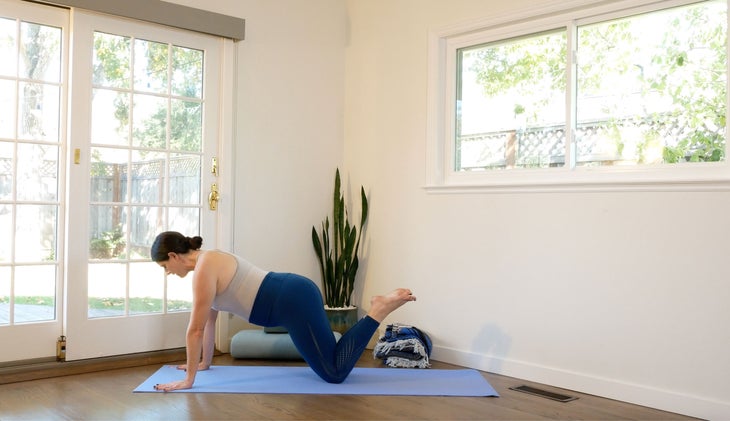
Modified Plank Pose
Why it works during pregnancy: One concern about overdoing it in pregnancy is the potential lasting effects of Diastasis Recti, which is when the necessary separation of the abdominal wall that occurs during pregnancy to accommodate the growing uterus remains separated after the baby is born. Postures that may exacerbate this condition are backbends and strong core work. For this reason, it can be wise to adapt your practice to omit Urdhva Mukha Svanasana (Upward-Facing Dog Pose). Also, to avoid overstraining, place your knees down before your lower from Plank Pose toward Chaturanga Dandasana (Four-Limbed Staff Pose).
How to: From Downward-Facing Dog Pose, inhale forward into Plank Pose and lower your knees to the floor. Lift your waist to prevent overarching your spine. On an inhale, shift your chest forward and, as you exhale, bend your elbows toward 90 degrees. On an inhale press back up. You may repeat this a few times back-to-back or return to Downward-Facing Dog and simply weave this throughout the sequence wherever you would normally take your vinyasa.
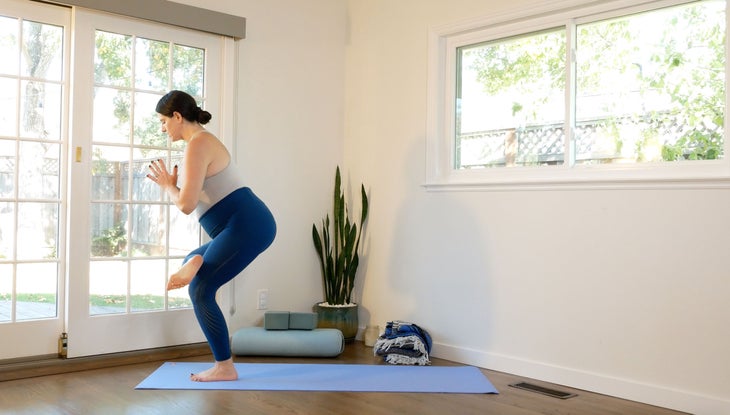
Utkatasana (Chair Pose) Variation
Why it works during pregnancy: One thing I absolutely love about prenatal yoga classes is the emphasis on squatting and leg strengthening. Your lower body—hips, pelvic floor, and lower back—are taken to task during the process of labor and birth, and the stronger your legs and spine, the more supported you will feel. In some cultures, people give birth in squatting positions and remain in that shape for hours at a time. (Even if you know you are going to get a cesarean, labor contractions can often involve a lot of downward pressure.)
How to: Stand at the top of your mat or near a wall for balance. Bring your feet hip-width apart. On an inhale, sit back into Chair Pose with your hands on your hips. Pick your left leg up and cross your ankle over your right thigh, coming into a figure-four shape. Depending on your balance, you might keep your hands in prayer or reach your arms overhead in line with your ears. Stay here for 8 breaths. Return to Chair Pose for one breath and then come back to standing and repeat on the second side. If you want more intensity, remain in Chair rather than come back to standing before your second side.
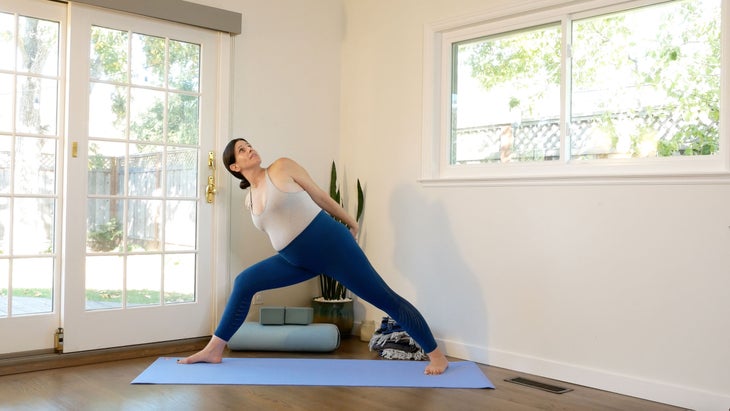
Utthita Parsvakonasana (Extended Side Angle Pose) Variation
Why it works during pregnancy: This standing pose also strengthens your lower body. And with this arm variation, it has the added benefit of being a shoulder-opener and mild backbend. Because many backbends are not advised—and, frankly, don’t feel great—during pregnancy, it is helpful to weave in chest and shoulder openers wherever you can.
How to: Stand and face the long edge of the mat. Step your feet out wide and turn your right toward the front of the mat from deep within your hip. Turn your back foot and hip in a bit. Align your feet heel-to-heel. Bend your front knee. On an inhalation, interlace your hands behind and your back. As you exhale, lean sideways over your front thigh, keeping your chest facing the side wall. If it is comfortable, you can look upward; otherwise, look anywhere that feels good on your neck. Stay here for 8 breaths. Inhale your torso upright and release your clasp. Straighten your legs and bring your feet parallel to one another facing the long edge of the mat. Repeat on the other side. Consider interlacing your other index finger on top when you clasp your hands.
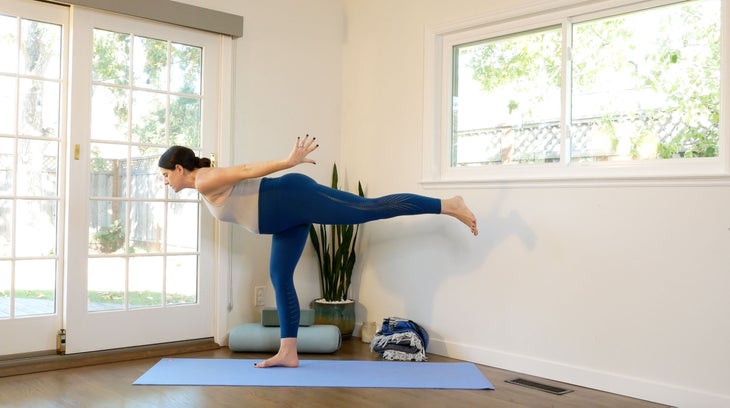
Chair Pose Variation into Virabhadrasana III (Warrior III) Transition
Why it works during pregnancy: Let’s be real. Balance is not easy during pregnancy in any trimester. In the first trimester, you are adjusting to changing fluid levels. In the second, you are acclimating to your organs moving. And during the third, your center of gravity is completely distorted. But this does not mean you should skip balance poses. In addition to strengthening your outer hips and legs, balance poses guide you to find an inner balance and repose, one that you will need through labor, birth, the newborn days, and let’s face it, the entirety of your parenting journey.
How to: Stand at the top of the mat and separate your feet hip-width apart. On an inhale, bend your knees and sit back into Chair Pose. Reach your arms in line with your ears. Stay here for a breath or two. Now, pick up your left leg and hover it an inch off the floor in a one-legged Chair pose variation. Stay here for 3 breaths. On an exhale, bring your hands to prayer at your chest, tip your torso over your pelvis and begin to reach your left leg back and start to straighten your standing leg into Virabhadrasana III (Warrior III). You might need to place your hands on the floor or blocks during the transition. Once balanced, remain here for 3 breaths. Now, slowly come out the same way you came in through One-Legged Chair pose, before lowering your leg back down and pausing in Chair. Press your feet to stand up and pause a breath before you repeat it on the second side.
You can personalize this sequence by flowing back and forth on single breaths or holding different portions. Have fun with it and remember: your body knows what’s best for you!

Vajrasana (Thunderbolt Pose)
Why it works during pregnancy: There is nothing more courageous than stillness. Like a master martial artist, the greatest warriors are often those who can be the quietest and most humble. This pose offers us an important moment to pause and check in. Please remember that relaxin may make certain joints achy or sensitive. If you feel any discomfort in your knees, try placing a rolled blanket behind your knees, or you may opt to sit in a cross-leg position.
How to: Kneel on your shins and sit on your heels. Sit up tall, so that the crown of your head is aligned above your pelvis. Place both hands on your baby and breathe. If you feel safe, close your eyes or simply look down. Pause here and sense into what you are feeling. There are a whole host of emotions that accompany pregnancy. This is a good time to observe and honor them. It is also a great time to pause and connect with baby.
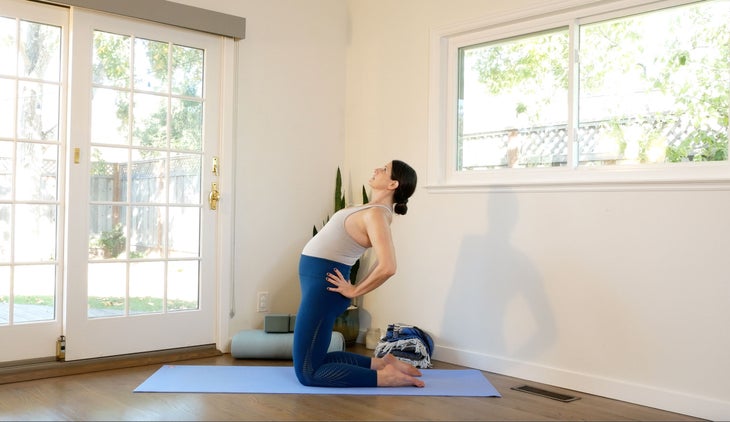
Ustrasana (Camel Pose) Variation
Why it works during pregnancy: As mentioned, bigger backbends are often contraindicated during pregnancy due to the risk of prolonged Diastasis Recti. This does not mean you can’t backbend at all. Backbends are still excellent at opening our hip flexors, the muscles that pull our thighs up to our chest. This camel variation provides a mild backbend for the spine, while opening the hips and pelvis. Take it slow and easy and be mindful and aware of any over-stretching sensation you might experience.
How to: From Vajrasana, stand up on your knees. If your knees are sensitive, tuck your toes or take some extra cushioning beneath your knees by folding the mat over or sliding a blanket underneath. Bring your hands onto your sacrum with your fingertips pointing down. On an inhale, lift your chest up to the ceiling. On an exhale, arch your back slightly. Now, maintaining this mild backbend in your uppermost spine, lean back with your body at your knee joints, so that your torso is diagonal from your knees. This requires a lot of leg strength, so if you need to bend at your hips to support yourself, please do so. Breathe for three and then come back upright. Pause as you sit on your heels. Repeat one more time.
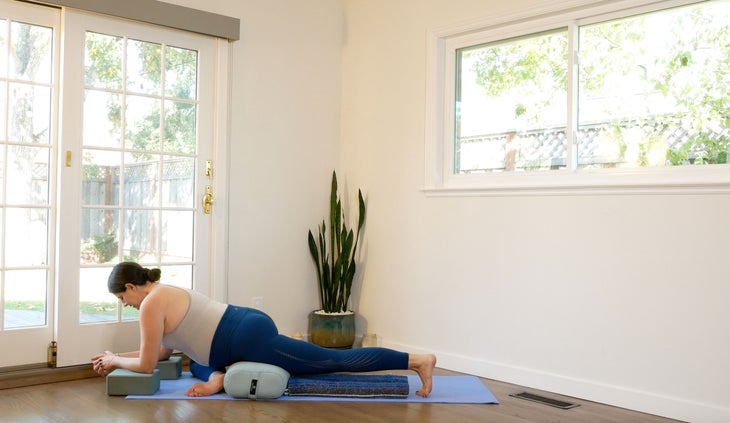
Supported Eka Pada Rajakapotasana (One-Legged Pigeon Pose)
Why it works during pregnancy: It’s time to start to give your legs and hips a well-deserved release. In pre-pregnancy Pigeon Pose, you might have been working toward getting your shin parallel to the top of the mat. Many prenatal teachers agree that pregnancy is not the time to work on deep stretching—it’s a time for status quo. For this reason, props can be a wonderful way to not only provide space for your baby, but also to provide additional support so your joints aren’t overloaded. Being upright in this pose is another opportunity for a chest opener.
How to: Come to hands and knees. Step your right leg around your right hand. Slide a bolster under you horizontally (this will support your right outer hip). Bring your right shin to the left. Pull your heel toward you as much as you need to, to maintain an even lower back and neutral pelvis (balanced on all sides). You can opt for a blanket under your back thigh. Have two blocks in front of you on the medium setting shoulder wide and place your elbows on them, propping your spine upright. Depending how it feels, you may be able to walk your hands forward and put your head down. Or you can opt to stay upright. Hold for 10 breaths. Come out slowly, walking your hands back. Bend your back knee and bring yourself back through Tabletop position. You may want to do a few Cat–Cows in between. Set up for your left.
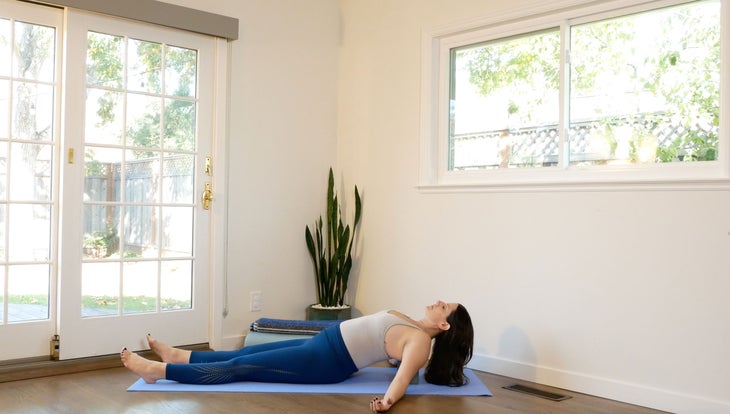
Supported Matsyasana (Fish Pose)
Why it works during pregnancy: Perhaps the most advanced pose we will do all day: resting in Savasana. Many doctors and prenatal experts recommend that people stop lying flat on their back after the second trimester, due to the weight of the uterus on the inferior vena cava, which is one of the main veins returning blood to your heart. When you stop is entirely personal to you. In my body, I know it’s time when I feel breathless and/or an increased heart rate. I stopped lying on my back much sooner during my second pregnancy. Propping your upper body up on a bolster or blocks, enables us to still enjoy being supine while also providing a mild shoulder opening.
How to: Set up two blocks at the upper half of your mat. The block closest to your feet is on the medium setting. The top block can be on the highest setting. Lie down so that your shoulder blades are directly on the first block (like a little shelf) and the back of the skull is supported by the top block. Bend your knees and place your feet on the floor hip-width apart. Release your arms by your sides. Explore straightening your legs and letting them fall open, but if you feel any sensation in the lower back, consider returning to bent knees. Once settled, remain for 5 full minutes. Coming out, bend your knees and place your feet on the floor. Roll to your left side (favoring your left side is another common suggestion across experts throughout pregnancy due to preventing pressure on the vena cava). Pause for a moment before pressing yourself up to sit.
Once seated, place one hand on you and one hand on your baby, representing the deep connection that is the utmost goal of any practice.
See also: Prenatal Poses for Each Trimester
About our contributor
Sarah Ezrin is an author, world-renowned yoga educator, popular Instagram influencer, and mama based in the San Francisco Bay Area. Her willingness to be unabashedly honest and vulnerable along with her innate wisdom make her writing, yoga classes, and social media great sources of healing and inner peace for many people. Sarah is changing the world, teaching self-love one person at a time. You can follow her on Instagram at @sarahezrinyoga and TikTok at @sarahezrin.
See also: More articles and sequences by Sarah Ezrin

